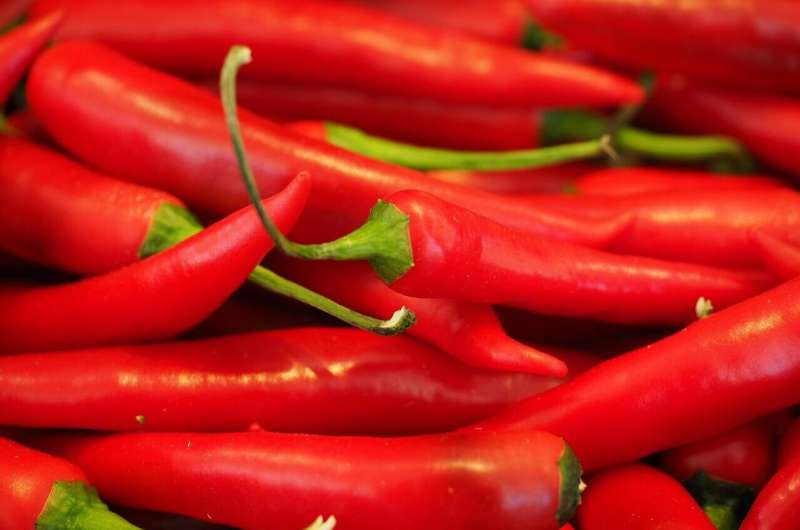This article has been reviewed according to Science X's editorial process and policies. Editors have highlighted the following attributes while ensuring the content's credibility:
fact-checked
trusted source
written by researcher(s)
proofread
Denmark bans noodles for being too hot—what you need to know about chili heat

Chili peppers—love them or hate them, they've got a heat that's hard to ignore. Recently, their fiery nature has even caused a bit of a stir in Denmark, where Buldak Ramen noodles have been banned for being dangerously spicy. So, what's behind the burning sensation we experience when we bite into a chili pepper, and why do some people seek out the masochism of a super hot curry or Korean instant noodles?
The culprit: Capsaicin
Chili peppers' illusion of heat is all down to a chemical called capsaicin. It binds to a protein called TRPV1, which sits in the membranes of sensory nerves, particularly in our digestive system (most notably our mouths), nose and skin.
TRPV1 is normally involved in our ability to sense painfully high temperatures. However, in the presence of capsaicin, the TPRV1 is triggered at lower temperatures, tricking us into reacting as if we're being burned.
This deception prompts our body to initiate an inflammatory response similar to what happens with actual burns, leading to swelling, sweating and discomfort. In fact, this very mechanism meant capsaicin was instrumental in identifying and studying the mechanisms involved in our ability to sense heat, for which David Julius received a Nobel prize in 2021.
In the wild, chili plants have evolved to produce capsaicin to deter mammals from eating the fruit. It seems that only humans are daft enough to actually seek out the chili-induced burning. The only other mammal that is happy to munch on chilies are some tree shrews, who have acquired a mutation in their TRPV1 genes making them able to tolerate high doses of capsaicin.
All birds, however, are unaffected by the spice, as their heat sensors work differently. Indeed, birds play a crucial role for the chili plant by consuming the fruit and dispersing seeds over a wide area.
This also makes for a good gardening life hack. If you are plagued with rats and squirrels eating bird feed then simply dose it with chili powder and any rodents will be deterred from returning for another taste.
How hot is hot?
The pungency of peppers is measured using the Scoville scale and Scoville heat units (SHU), developed by Wilbur Scoville in 1912.
The original method involved extracting capsaicin from the peppers and then diluting the solution until a group of volunteers could no longer feel the heat. For example, if 1ml of a jalapeño chili extract had to be diluted in ten liters of water before the taste testers could no longer sense it, then the jalapeño would sit at 10,000 on the Scoville scale.
This was a rather subjective method, so in the 1980s it was replaced with a more analytical method that directly measures the concentration of capsaicin in the extract.
However, the scale still bears Scoville's name. On that scale sits the perfectly palatable sweet bell pepper (zero SHU), the heady heat of a Tabasco pepper (up to 50,000 SHU) and the extreme pain of the world record holder—Pepper X (2.7 million SHU).
Meanwhile, various online sources claim the hottest Buldak Ramen noodles sit around 9,000 SHU.
The perils and pleasures of spicy food
Eating extremely spicy food can be an intense experience. Many of us enjoy the hot sensations, and some people report a spice-induced natural "high", which may be caused by the release of endorphins in response to the spicy heat.
Meanwhile, we've all seen those videos of people sweating, turning red and sometimes even crying after biting into something too hot.
Consuming too much spice can certainly lead to sweating, nausea, vomiting and some gastrointestinal distress. But there isn't a great deal of evidence for serious or long-term health issues directly linked to hot food, leading some to wonder if the Danish authorities overreacted.
Dealing with the heat
What do you do if you've bitten off more than you can chew, spice-wise?
Drinking water won't help. In fact, it can make things worse by spreading the capsaicin around your mouth. Instead, reach for something fatty. Capsaicin dissolves in fat, so drinking full-fat milk, eating yogurt or even nibbling on some cheese can help.
Acidic foods like lemon or lime juice may help to neutralize the heat, and starchy foods like bread or rice can absorb the capsaicin and give your mouth a break. Of course, these may alleviate the fire in your mouth, but it may be too late to help with any follow through.
Provided by The Conversation
This article is republished from The Conversation under a Creative Commons license. Read the original article.![]()





















